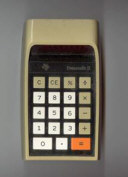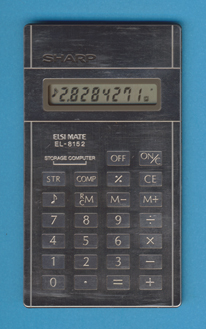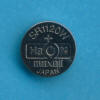
DATAMATH CALCULATOR MUSEUM
 |
DATAMATH CALCULATOR MUSEUM |
Sharp EL-8152
| Date of introduction: | March 1979 | Display technology: | LCD |
| New price: | ¥7.900, $39.00 | Display size: | 10 |
| Size: | 3.8" x 2.1" x 0.13" 96 x 54 x 3.3 mm3 |
||
| Weight: | 1.4 ounces, 39 grams | Serial No: | 97016936 |
| Batteries: | 2*SR1120 | Date of manufacture: | mth 06 year 1979 |
| AC-Adapter: | n.a. | Origin of manufacture: | Japan |
| Precision: | 8 | Integrated circuits: | |
| Memories: | 1 | ||
| Program steps: | Courtesy of: | Joerg Woerner |

![]()


 World’s first 1.6mm-thin
electronic calculator. This EL-8152 is an astonishing 1.6 mm thick (that's
1/16"), thin enough to earn a place in the Philadelphia Museum of Art's Post-War Japanese Design exhibit of
several years ago (the only pocket calculator in the exhibit). John Keiffer - a
proud owner of the EL-8152 reported us recently that the calculator is only in the
keyboard area that thin. The battery and display area measures 3.3 mm or
0.13". An unusual feature of the EL-8152 is a twin memory, the common
[M+], [M-] memory and a separate "Storage Computer".
World’s first 1.6mm-thin
electronic calculator. This EL-8152 is an astonishing 1.6 mm thick (that's
1/16"), thin enough to earn a place in the Philadelphia Museum of Art's Post-War Japanese Design exhibit of
several years ago (the only pocket calculator in the exhibit). John Keiffer - a
proud owner of the EL-8152 reported us recently that the calculator is only in the
keyboard area that thin. The battery and display area measures 3.3 mm or
0.13". An unusual feature of the EL-8152 is a twin memory, the common
[M+], [M-] memory and a separate "Storage Computer".
Sharp has referred to this unit as the world's thinnest calculator of its time; it is no doubt
a tour de force of miniaturization. Whether it was the first unit of this size is
subject to debate:
Casio produced the LC-79, a calculator of approximately 2 mm thickness (1.9 mm was stated in Casio advertising
- but this wasn't the whole truth), as early as 1977,
according to Casio's records. In the year 1985 Sharp won the race of
miniaturization with the EL-900.
This ultimate thin calculator measures 0.8 mm (that's 1/32").
(Authors note: Casio introduced already in November 1983 the
FILM CARD SL-800 with 0.8mm thickness, too.)
Learn how to decipher the 97016936 Date code hidden in the serial number of the pictured calculator)
Don't miss the EL-8153 with a somewhat thicker housing and the membrane keyboard.
Read more about Sharp Corporation’s Calculator Innovations.
If you have additions to the above article please email: joerg@datamath.org.
© Joerg Woerner, December 25, 2001. No reprints without written permission.